After a drenching rain the night before, one of my botanizing friends, Alan Cressler, joined me on a day trip to Richland County (in central South Carolina) to see a rare Trillium, called Trillium oostingii or Wateree Trillium:
How this Trillium got its name is an interesting story: In April, 2002, a well-known local botanist named L. L. “Chick” Gaddy, found an unusual Trillium in Kershaw County, South Carolina. This sessile-flowered plant was growing in rich floodplain woods along the Wateree River near the Fall Line of South Carolina. Although he easily recognized the plant as a Trillium, he could not identify the species.
Over the next few years, Chick Gaddy found several additional sites where this plant was locally abundant. As with many rare or endangered species, their large numbers at a particular location usually gives no clue of their true rarity. While doing research to attempt to identify this plant, Chick discovered that a botanist named H. J. Oosting had found a similar plant along the Wateree River flood plain in 1937, but he had thought the plant to be another species, Trillium viride, which is not found anywhere near South Carolina.
After several years of exhaustive research (including DNA analysis) of these re-discovered plants, Chick determined that it had not been properly described and was a species new to science, and he named it Trillium oostingii, after its original discoverer.
in 2012, I decided that I wanted to photograph this rare Trillium, so I did a bit of research on my own, and I located a person, who knew a person who owned some land bordering the Wateree River. This land owner (who will remain nameless to protect his interests), had recently found a population of this newly-named species on his property. After setting up a meeting with the land owner, I traveled down-state to meet him. He was more than gracious in showing me a wonderful population within spitting distance of the river. It turns out that to get to these plants, one has to navigate several miles of a tortuous and muddy unpaved swamp road — definitely not fit for the faint-of-heart.
The petals of this species are a pleasing shade of yellow-green with a dark maroon color at the base of each petal, quite unlike any other species that might be found in the central portions of the state. When the flowers are fresh, the petals tend to bulge a bit at the base and point straight up — the sepals bending down beneath the leaves. As the flowers age, their petals relax and open a bit, and their sepals assume a more horizontal position:
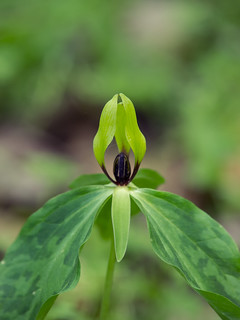 |
 |
Upon arriving at the first site we visited that day, we were greeted with several large clumps of Wateree Trillium:
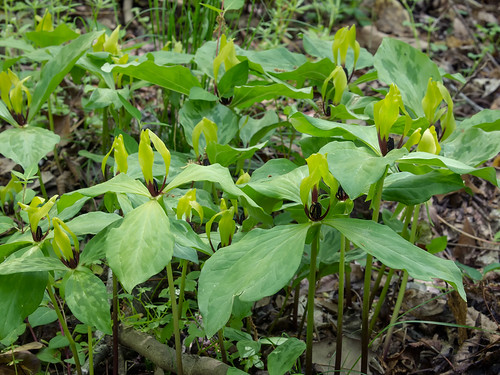
It is not unusual for some species of Trillium to form clumps, but these were of considerable size and were quite impressive.
The land owner told us of a second site that hosted many more plants. Visiting this second site required our navigating a seldom-used “trail” through the woods and into an old cow pasture. We were able to drive to the pasture, but I didn’t feel comfortable driving any farther, even though my truck is equiped with 4-wheel drive. After parking at the far edge of the pasture, we packed our gear and walked a path into the woods.
We soon began to see a few plants scattered here and there and generally associated with Podophyllum peltatum, commonly called Mayapple:
 |
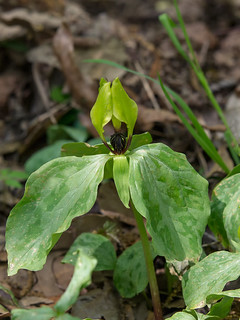 |
Farther down the path, we began to see many hundreds of Trillium plants growing in the woods among a thick layer of the noxious weed, Galium aparine, commonly known as Goosegrass, Bedstraw, Stickywilly, or Catchweed — the latter two common names coming from its ability to use the tiny hooks on its leaves to attach itself to the fur of animals or clothing. Even though there were many very nice Trillium specimens here, the abundance of this weed made it quite difficult to isolate the plants in a photograph. The color of the weeds closely approximated the color of the leaves and petals of the Trillium:
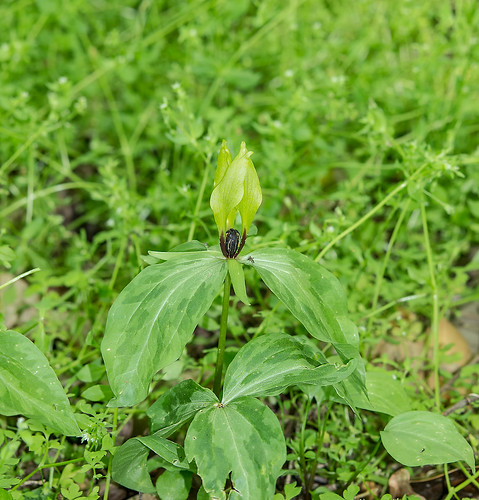
Apparently, the Trillium plants are not too bothered by the mat of this invasive weed — they seem to be thriving…
Earlier in the day, on our way to the Trillium sites, we had passed a spectacular field of Zephyranthes atamasca, commonly known as Atamasco Lily or Rain Lily. Neither Alan nor I had ever seen such an impressive display of these fragrant, white flowers:

Here are a couple of shots of Alan — first trying to decide which ones to photograph, then finally deciding on a group shot:
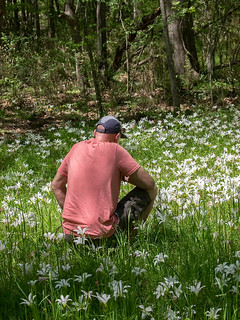 |
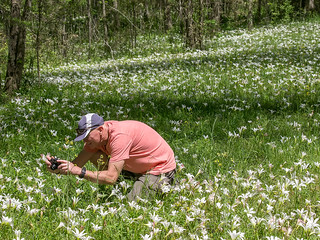 |
Here are a couple of shots of the flowers up close:
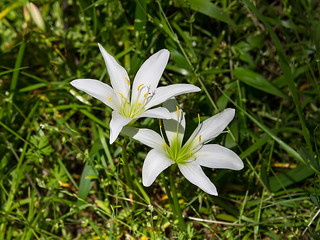 |
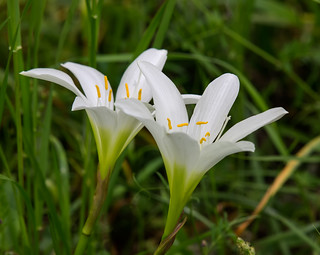 |
Again, the coverage of these plants was so extensive that I could see additional sections of this population streaching into and through the adjoining woods. What an unexpected but very pleasant surprise:
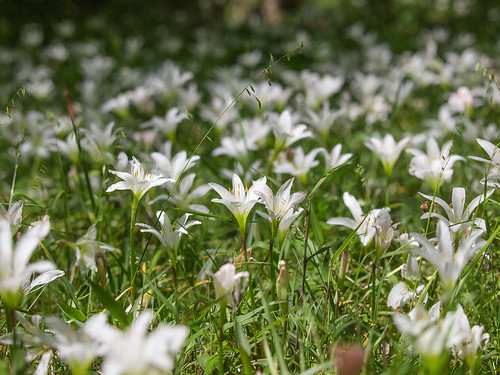
After finishing our work at this spectacular site, we headed off to visit Forty Acre Rock, a very large “flat rock” granite outcrop in Lancaster County that hosts many rare plant species. This would be Alan’s first visit to Forty Acre Rock, but it was my second visit. More about this visit in an upcoming blog post. Here is the link to my first visit to Forty Acre Rock, a week prior to photographing the Wateree Trillium:
— Jim

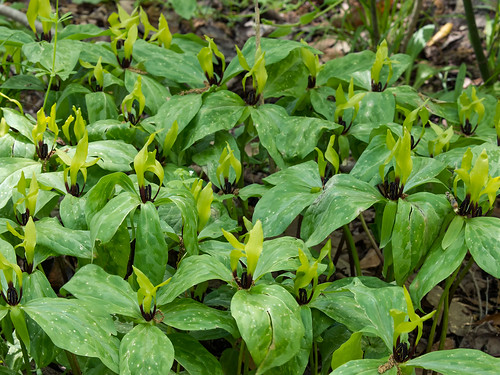
0 Responses
Enjoying your descriptive posts. Each makes me want to visit. I did see Atamasco Lily in Charleston, SC once. There were two plants, and I was still impressed.
That was my experience, too, Charles. This large group was a bit overwhelming! 😉
Nice to see this newly described trillium; enjoyed the post and all the info; nice patch of Atamasco Lilies too.
A search on the lily leads me to this post. Such a unique trillium!
You may want to read Meadow Across the Creek by Thomas Berry at http://thomasberry.org/publications-and-media/the-meadow-across-the-creek. We believe the flowers Thomas saw that day were Atamasco Lilies. Your pictures are beautiful.
Ann